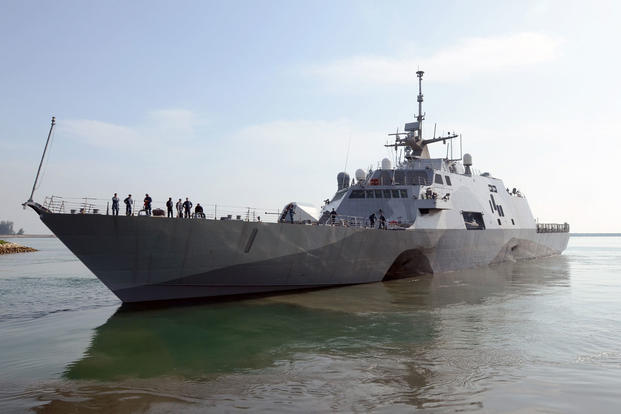Navy Secretary Ray Mabus told lawmakers Wednesday that the service hopes to expand and speed up modifications to its fleet of Littoral Combat Ships so that technological upgrades slated for a new variant of the ship are retrofitted onto the existing fleet before 2019.
The Navy plans to begin procurement of a new up-gunned, more survivable LCS variant, called a Frigate or FF, by 2019 – so that the last 20 ships in a planned fleet of 52 LCS are equipped with additional lethality and survivability technologies.
Now, as directed by former Secretary of Defense Chuck Hagel, the Navy is preparing to unveil its acquisition strategy for the new vessel by May of this year. Part of this new strategy includes speeding up the upgrades to begin prior to the previously scheduled 2019 date, Mabus explained.
"We are working on survivability and lethality upgrades for ships past 2019 -- for ships through 52. We are hopeful that we can move that up some so that we don't wait until 2019 for modifications," Mabus said Wednesday to the Senate Appropriations Committee – Defense Subcommittee. "It's a very high priority."
At issue is the extent to which considerable technical modifications to the ship planned for the new FF variant can be back-fitted onto other existing LCS and those under construction.
Among other things, the modifications include a long-range beyond-the-horizon missile capability, specially configured space armor, improved air defense radar and a more effective electronic warfare system, Navy officials said.
The Frigate will also be engineered with a multi-function towed array sonar, torpedo defenses and an improve decoy system to divert incoming enemy fire. Along these lines, the FF will also incorporate an upgrade to a missile-interceptor ship defense system called SeaRAM.
"When you add the variable depth sonar in conjunction with the multi-function towed array, you've got the most effective ASW sensor platform in the Navy. You add to that a helicopter with this torpedo capability, now you've got a detect and kill capability on the ship unlike any other platform in the Navy," Navy acquisition executive Sean Stackley told reporters last year.
The new ship will also be configured with what's called improved signature management, meaning technologies which make the vessel less detectable to enemy radar and less susceptible to enemy mines.
Alongside the new modifications, the ship will also incorporate many of the weapons systems and technologies currently on the LCS such as 30mm guns, a ship-launched Hellfire missile, 11m rigid inflatable boats and a 57mm gun.
The new modifications will add about $65 to $70 million to the price of the ship, an increase which amounts to about 20-percent of the overall cost of the ship, Navy officials said. Current LCS ships cost from $380 to $400 million or more per ship, service officials have explained.
Instead of focusing on interchangeable sets of technologies called mission packages like those used for the existing LCS, the new modified ship will simultaneously be configured for surface warfare and anti-submarine warfare, Chief of Naval Operations Adm. Jon Greenert said.
Mine counter-measures mission packages will be handled by the regular LCS ships already in production.
Regarding a production path forward, the Navy plans to continue its current two-variant system for the new Frigate; the current LCS is built in a flat-bottomed Freedom variant built by Lockheed and an Independence variant with a trimaran hull built by Austal USA.
"We plan to continue the 50-to-50 split between the two shipyards. We have found that having two shipyards and having two variants has been very helpful in a number of ways" Mabus said, adding that the dual shipyards increase competition and drive down costs for the ship.
"Each ship brings some unique capabilities and capacities that the other one doesn't," he added.
The new Frigate emerged as a result of recommendations to former Defense Secretary Chuck Hagel from a specially configured unit tasked with analyzing possibilities for a new LCS variant called the Small Surface Combatant Task Force.
In January of last year, Hagel instructed the Navy that there would be no new contracts awarded for LCS production beyond 32 ships, directing the Navy to consider a host of alternative proposals for the remaining 20 ships slated to complete the 52-ship program.
Hagel cited many criticisms of the LCS platform such as concerns that it lacked the lethality and survivability that it needed to complete its desired range of mission sets. As a result, he inspired the creation of the Small Surface Combatant Task Force which focused vigorously on identifying a new LCS design featuring vastly improved survivability.
The task force explored more than 192 different design concepts and consulted with fleet commanders, industry, surface warfare officers, engineers and program managers, among others.
-- Kris Osborn can be reached at kris.osborn@military.com



























